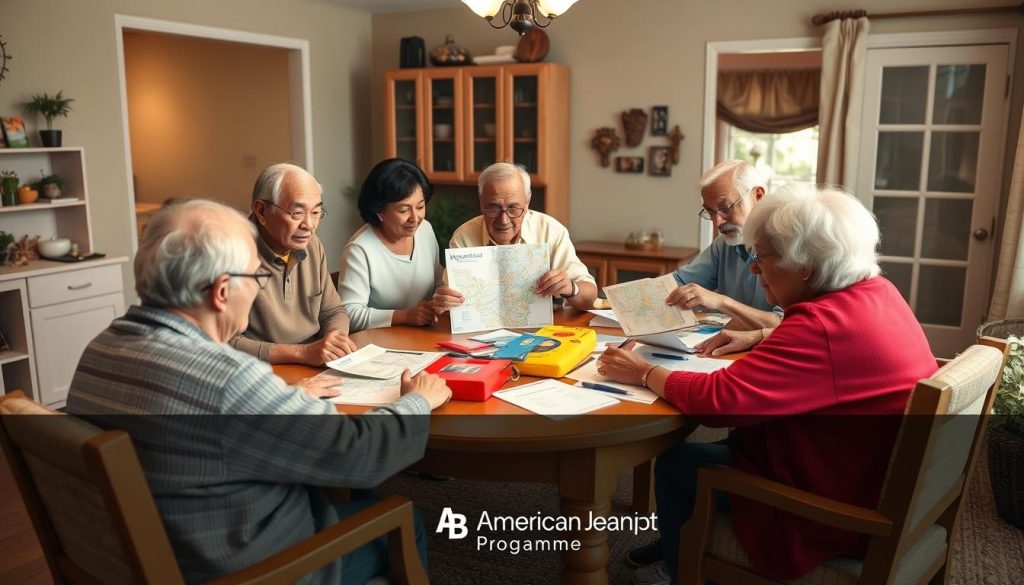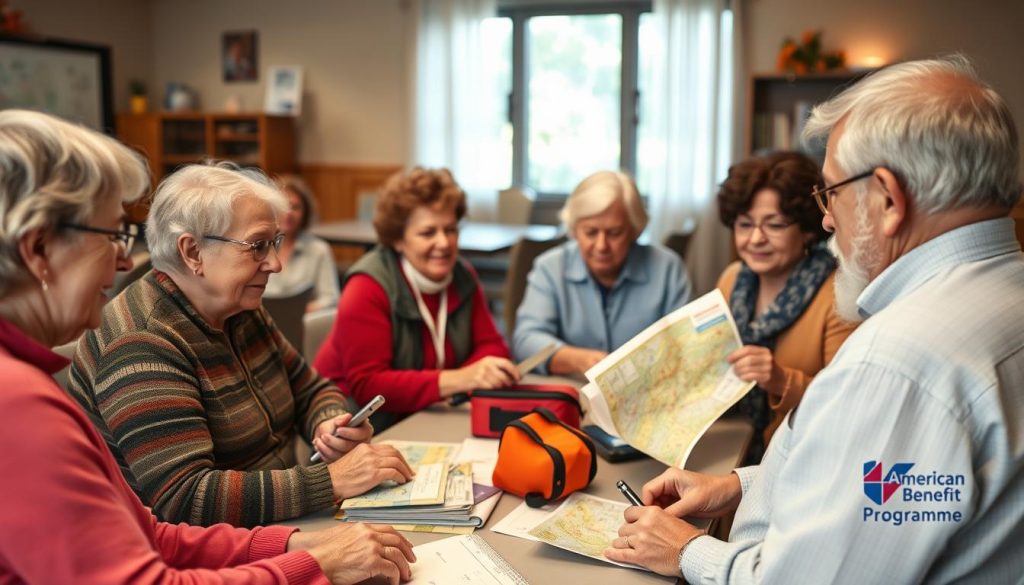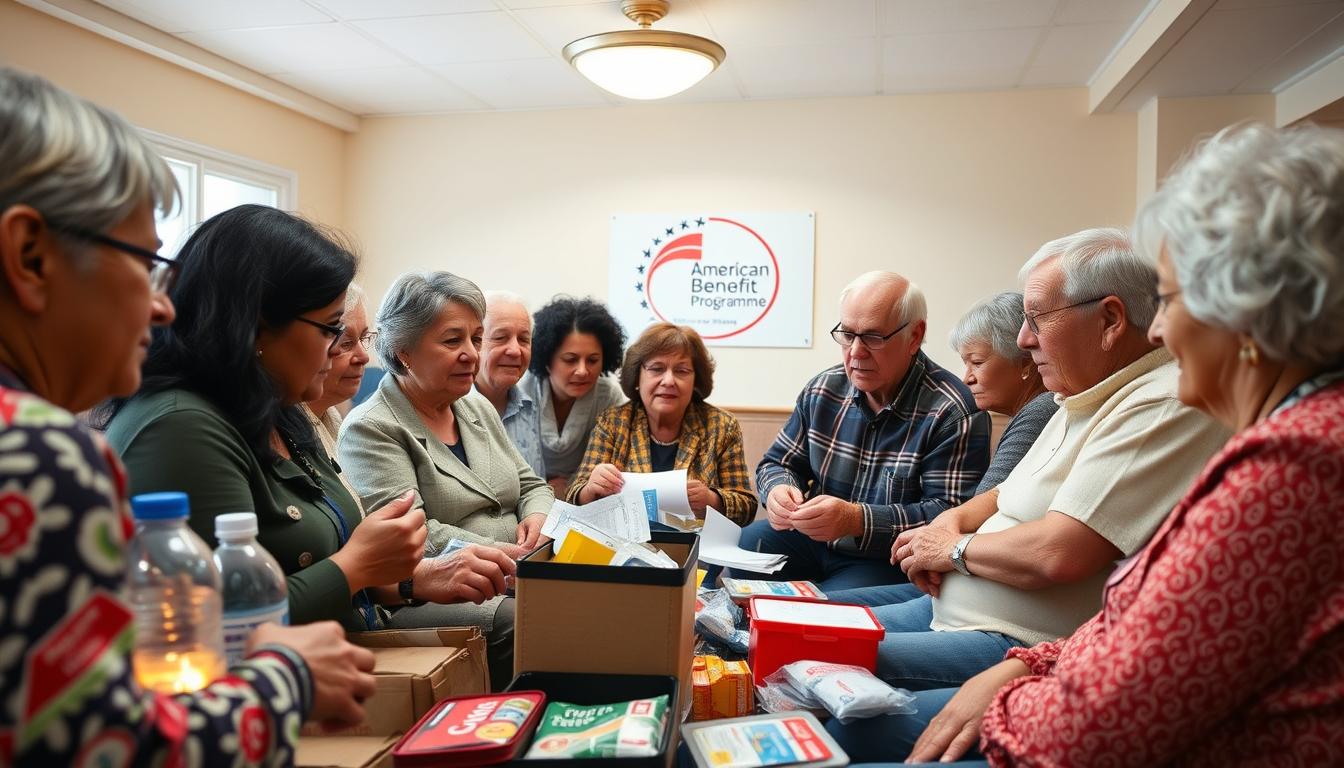Did you know nearly 50% of older adults feel unprepared for emergencies? They are very vulnerable during disasters. It’s important to show how ready seniors can really make a big difference. We’ll look at a plan made for older adults’ needs, stressing the importance of being proactive.
Emergencies come without warning, so having a good plan and people to help is vital. This guide takes you through steps designed for seniors’ unique challenges. It helps them react well and stay safe in crises123.
Key Takeaways
- Understanding the different components of senior disaster preparedness is vital for their safety.
- A well-structured emergency plan involves assessing individual needs, creating a thorough plan, and engaging support networks.
- The Disaster Preparedness Guide for Older Adults promotes tailored messaging for diverse needs.
- Creating a disaster supplies kit ensures seniors have essential items readily available during emergencies.
- Regular practice of emergency plans with family and caregivers strengthens preparedness.
Understanding the Importance of Senior Disaster Preparedness
It’s very important for older adults to be ready for emergencies. They might face more problems because of their age. Things like moving around, needing certain medicines, and being alone can make disasters harder for them. A big ice storm in New York showed that older people need plans for these times4. Getting ready for disasters helps seniors feel in control when things are uncertain.
Seniors need people to help them. Sometimes, help from local groups can take a while. It’s important to have a plan with family and friends4. Talking about how to get help in an emergency is key. It’s good to have a team of caretakers and neighbors ready to help5.
Being prepared can lower the risks for older people. Making an emergency plan is a big step. This plan should have personal information, escape plans, and a kit with needed items for three days4. The kit should have water, food, medicine, and things to stay clean. Keep the kit up-to-date so it’s always ready.
Being prepared can save lives in emergencies. Knowing the dangers in your area helps make better plans6. Using local information helps seniors understand what to watch out for. This makes their planning better and safer.
| Common Risks | King County, WA | Hudson, NJ |
|---|---|---|
| Earthquake | Medium Risk | Medium Risk |
| Flood | Low Risk | High Risk |
| Wildfire | Low Risk | Low Risk |
| Extreme Heat | Affects many seniors | Affects many seniors |
Common Disasters and Their Impact on Seniors
Older people face greater risks in disasters due to health issues. About 80% of them deal with chronic illnesses. This makes them more vulnerable during hurricanes, floods, and wildfires7. These events can make it hard to evacuate, especially for those who move with difficulty. They might also need immediate medical help afterwards.
The mental effects are just as big a problem. Seniors are more than twice as likely to feel PTSD after a disaster7. A study found that disasters can make older people feel alone8. About 78.7% of older folks had few or no PTSD signs after disasters. Yet, 16.0% had long-term PTSD7. Not having power for necessary medical devices adds to the challenge of preparing for emergencies8.
Heatwaves are especially dangerous for the elderly. In one Pacific Northwest heatwave, 80% of those who died were 60 or older9. Flooding is tough for seniors, too, especially in places where water levels are rising. This includes many care facilities in Florida9. It’s important to have a good emergency plan for senior safety in such situations.
Step 1: Assessing Your Needs for Elderly Disaster Readiness
Seniors must first look at their own needs and limits to get ready for disasters. This step is very important because it sets the stage for making plans that fit their needs. Knowing what you might face helps older people deal with emergencies better.
Identifying Personal Limitations and Risks
Knowing your limits is key to getting ready for disasters. Seniors should think about:
- Health issues that need constant care.
- Mobility problems that could make it hard to leave quickly.
- Depending on tools or others for help.
- Ways to talk to others, especially where getting help is hard10.
Having friends and community is very important. They help you get resources and help fast during tough times10.
Understanding Medical and Mobility Needs
It’s important to know what medical and moving around needs you have for planning. Seniors should think about:
- How to get out safely.
- Having caregivers who know what to do in an emergency.
- Being able to reach your meds and equipment you use every day10.
In an emergency, older adults need a plan for basic stuff like food, water, and key papers. It’s good to keep at least one gallon of water per person each day for two weeks. Also, store food that doesn’t go bad for two weeks11.
By doing these things, seniors can be better prepared for disasters. They will be safer and get to important resources and help quickly when needed.
Step 2: Creating a Comprehensive Emergency Plan
Making a strong emergency plan is very important for seniors. It shows how to react well in a crisis. Including family and friends in this plan helps. They learn what to do. This makes giving help easier when things are tough.
Involving Family and Friends in Planning
Adding loved ones to seniors emergency planning builds a support circle. Talking often helps everyone know their part. This ensures everyone works together. Picking two places to meet makes leaving safer during trouble12.
Developing an Escape Route and Meeting Points
It’s important to know how to leave your home safely. Mark several ways out for different dangers. Choosing places to meet before anything happens keeps things organized if you need to leave13. Try leaving your home twice a year. This helps everyone remember the way12.
Establishing a Family Communication Plan
Having a good talk plan helps a lot in emergencies senior citizen emergency response. Make a list of important people to contact. This list should include family and friends who live far away. Use texts for quick messages when calling might not work12.
Planning for Pets and Assistive Devices
Think about pets and needed tools in your emergency plan. List things you must have, like lots of water (1 gallon per person each day for 3-5 days), medicines, ID, a first aid kit, and stuff for personal cleanliness13. Don’t forget your pets. They’re part of the family and need special care when there’s danger12.

Step 3: Assembling Your Disaster Supplies Kit
Making a disaster supplies kit is key for keeping seniors safe. The kit needs things that meet their special needs. This helps them stay safe and comfortable in emergencies.
Essential Items for Seniors
Here’s what you need in a disaster kit for seniors:
- At least one gallon of water per person for three days. Try for two weeks if you can1415.
- Food that won’t go bad quickly, enough for three days16.
- Prescription drugs, since many people need daily medicine15.
- A first aid kit with medical supplies.
- Things for personal cleanliness like moist towelettes and trash bags16.
- Emergency cash or checks for surprises16.
- Snacks and things to calm stress in hard times.
Regularly Updating Your Supplies
It’s important to keep the emergency kit for seniors up-to-date. Replace things like water, food, and medicine every year. Make sure everything is good to use and not expired1415.
Special Considerations for Cold and Warm Climates
When making an emergency kit, think about the weather. In cold places, add warm clothes and extra blankets. In hot places, include things for staying hydrated and sun safe. Your kit should be ready for the season to keep seniors ready for anything.
Senior Disaster Preparedness: Utilizing Support Networks
For senior citizens, building a strong support network is key. This network can include family, friends, and community helpers. They all play a big role in getting ready for emergencies. Talking often is crucial, as it makes older people feel cared for and connected.
It’s also important to work well with others. This can make planning and reacting during disasters better. It helps keep senior citizens safe.
Getting help from the community is very important. Local groups provide many services like rides, checks, and help finding more help. Knowing about these services helps seniors do well, even when things get tough. Places like community centers help seniors get ready for disasters. They also help them meet and support each other. Talking with family about what to do in emergencies is also helpful.
Making a list of what you need is a good step. This list should include things like food, water, medicine, and clean-up stuff. You’ll need enough to last at least three days17. Sharing resources at these talks is smart. This way, seniors won’t be left without help. It’s also smart to team up with neighbors. This makes a strong local group that can look out for each other.
Being ready for disasters takes ongoing work. Keep checking your plans and supplies to stay prepared. For more tips on getting ready for emergencies, check out these preparation guidelines.
Staying Informed and Engaged with Community Resources
Knowing local emergency plans helps keep seniors safe. Learning about services for seniors can teach them how to react in disasters. Talking to local first responders gives seniors important safety tips.
Big emergencies like Katrina and Superstorm Sandy have shown how seniors can be more stressed afterwards18. Being connected to local help is key for good emergency plans for old people. It helps them find support when things get tough.
With more wildfires and hurricanes, using local services in emergency plans is key19. Building a support network with family, friends, and neighbors is very helpful. They suggest safe meeting spots and keep medical info up to date. Being proactive keeps seniors safe and part of their safety planning.
Training and Resources for Senior Citizen Emergency Response
It’s key to teach seniors how to handle emergencies. There are many training programs for seniors. They focus on making them better at responding to emergencies. Workshops go over important things like first aid and CPR. This prepares them for different situations.
Groups offer tools to help with disaster preparedness for older adults. Seniors learn to make a disaster kit. It has must-haves like medicine and tools to help them move. The kit should last at least 30 days20. They also learn to keep a list of contacts for emergencies20.
Learning how to get supplies for home, car, or leaving is important20. The California Department of Social Services helps seniors during disasters21. They can call 1-800-677-1116 for special help programs21.
Tools like the Medical Information Card help seniors in bad times22. There’s also 24/7 help for those feeling upset because of disasters22. Getting this training and tools makes seniors stronger and safer.

Practical Tips for Senior Safety During Disasters
Making sure older people stay safe in emergencies means taking several steps ahead of time. They should keep up with weather updates and local news. This lets them know about possible dangers23. Having a plan ready for sudden disasters is key.
Every older adult needs a well-stocked emergency kit. It should have at least one gallon of water per person for each day, enough for three days if they have to leave and for two weeks if they stay home24. The kit must include flashlights, extra batteries, and a first aid kit24. They should have these supplies ready at home, in the car, and for leaving if needed. This helps them handle surprises well.
Seniors should know two ways to get out of any room, in case of fire23. Having a list of emergency contacts is wise. It helps them reach out if phones go down. They should also keep copies of important papers easy to grab23. Talking with utility companies about shutting off services if needed is a good idea24.
Staying in touch with family gives emotional support in tough times. Older people should talk about their safety plans with family. This builds a network of support. The website Ready.gov has specific advice and more ideas for staying safe25.
Conclusion
Getting ready for disasters is key, especially for older people. It’s not just helpful; it’s very important. As more elderly people live in our communities, making sure they have emergency plans is crucial. These plans help them feel safe. They also make our communities stronger2627.
For these plans to work, they need to be checked and updated often. Working together with groups that know about disasters can help a lot. This teamwork helps older people and their families get ready for any emergency. It makes sure they stay safe28.
Making a good disaster plan for seniors is something we should all help with. Teaching and working together improves how well older people can handle surprises. When we all do our part, seniors are not just surviving; they are living well2627.
Source Links
- Older Adults | Ready.gov
- FEMA Introduces Disaster Preparedness Guide for Older Adults
- Older Adults
- Disaster Preparedness | SeniorLiving.org
- VA.gov | Veterans Affairs
- Disaster Preparedness and Recovery for Older Adults
- The Impact of Disasters on Older Adults
- FEMA Disaster Preparedness Guide for Older Adults
- Disaster Preparedness Plan
- Five Steps to Create an Emergency Disaster Plan for Older Adults
- Step 3: Organize Disaster Supplies
- Build A Kit | Ready.gov
- How to Build a Kit for Emergencies
- Community Engagement in Disaster Preparedness and Recovery: A Tale of Two Cities – Los Angeles and New Orleans
- Older adults and disasters: How to be prepared and assist others
- Older Adults
- Emergency Preparedness & Response – Helpful Tools & Tips | California Department of Aging
- Emergency Preparedness | ACL Administration for Community Living
- Older Adults
- Disaster Preparedness for Older Adults in Rural Areas
- Disaster Preparedness Intervention for Older Adults (Seniors’ Positive Involvement in Community Emergencies): Protocol for a Quasi-Experimental Study
- Disaster Preparedness Intervention for Older Adults (Seniors’ Positive Involvement in Community Emergencies): Protocol for a Quasi-Experimental Study – PubMed

Leave a Reply